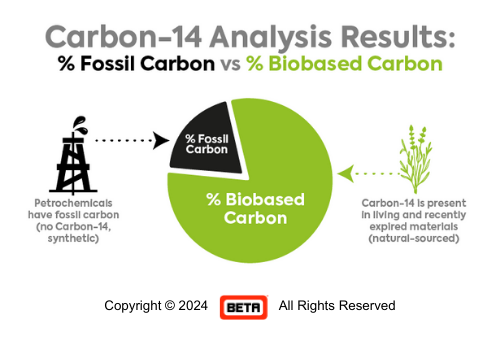Trends leaning in favour of natural ingredients have been on the rise in recent years as consumers educate themselves on the ingredients used in their products. A 2021 study by Simon-Kucher & Partners revealed that 63% of consumers are now opting for more natural ingredients when making their purchasing decisions.1 In response to this shift in consumer behaviour and an overall higher awareness of the benefits of natural ingredients, some companies are exchanging petrochemical-derived, synthetic ingredients for their biomass-derived (natural sourced) counterparts. Thus, a reliable scientific method to verify the naturality of ingredients and confirm they are sourced from biomass is needed in order to back up claims that ingredients are truly natural. Natural product testing uses carbon-14 analysis to measure natural sourced content, providing vital data needed to verify the natural source of raw materials and finished products
Carbon-14 Natural Product Testing
Carbon-14, or radiocarbon, is a radioactive isotope of carbon present in the atmosphere and all living organisms. These organisms possess a known level of carbon-14, allowing it to be measured to determine whether a material comes from biomass. Because the carbon-14 isotope has a detection limit of approximately 50,000 years its presence in biomass is significant because petrochemical-derived materials do not contain any carbon-14. Therefore, analysis reveals whether a product is naturally sourced from biomass or if it’s made with petrochemical-derived substances. Carbon-14 natural product testing is conducted with an accelerator mass spectrometry (AMS) instrument according to international analytical standards such as ASTM D6866 and ISO 16620-2.

Natural product testing verifies natural sourced carbon content and is applicable to liquid, solid, and gaseous samples. Results are reported as a percentage (%) of biobased (containing ingredients originating from biomass) carbon content ranging from 0% to 100%. This percentage represents the portion of the product that comes from biomass. An entirely natural sourced product will yield a 100% biobased result while a product that contains 100% petrochemical-sourced, synthetic ingredients would be 0% biobased. A result in between indicates a mixture of natural sourced and synthetic/petrochemical sourced ingredients. Carbon-14 is an accurate and easy to understand tool to identify if a material or product is made from ingredients that are naturally sourced from biomass or synthetic.
The Benefits of Natural Product Testing
One of the primary uses of natural product testing is to ensure a product is truly natural and does not contain synthetic adulterants. Natural product testing results provide clear scientific evidence that a product’s ingredients are verifiably natural and biomass-derived. Analysis also provides valuable data to back up and validate natural claims to promote consumer and market trust. Additionally, natural product testing allows companies to obtain vital data for quality control purposes, research and development (R&D), as well as formulation and optimization of products during the phasing out process of synthetic ingredients.
Determining natural sourced content is also one of the most reliable ways to counter the practice of economically motivated adulteration. Ingredient adulteration occurs when synthetic ingredients are used in place of their natural versions, but the fact that the ingredients are synthetic is not disclosed to consumers. The practice is common because natural ingredients tend to be more expensive and more difficult to source than their petrochemical-derived, synthetic counterparts. Ingredients such as curcumin, for example, are often adulterated due to cost and availability.2 To add to this problem, natural and synthetic ingredients are chemically identical and the difference is often undetectable by common analytical methods. Natural product testing, however, can accurately detect the difference between natural and synthetic ingredients because natural sourced ingredients will contain a measurable amount of carbon-14 while synthetics will not.
Garlic Oil and Economically Motivated Adulteration
Garlic oil is a common ingredient within the health and nutrition industries. Ingredient adulteration is prevalent when it comes to garlic oil because its extraction rate is low. A large amount of raw materials is required to obtain a few ounces of oil, therefore the market price for natural garlic oil is high.3 For this reason, garlic oil is prone to economically motivated adulteration as the synthetic version is cheaper and easier to obtain compared to authentic garlic oil. Adulteration can occur in a few forms, one being the use of lower quality ingredients to replace more expensive, higher quality materials. The use of lower cost ingredients and synthetically derived ingredients are also forms of adulteration. These practices can lead to a lack of disclosure to consumers when synthetics are used to replace their natural counterparts. For this reason, it is important to utilize reliable third-party analytic methods to authenticate expensive or difficult to procure ingredients and identify whether they are genuinely natural.
Garlic Oil Authentication Case Study: Carbon-14 versus GC-MS Analysis
A case study conducted by Beta Analytic reviewed the accuracy of two common ingredient authentication methods, Gas Chromatography–Mass Spectrometry (GC-MS) and carbon-14 natural product testing via accelerator mass spectrometry (AMS).4 GC-MS analysis produces chromatograms that show the composition of a sample at the chemical level. AMS carbon-14 testing measures the amount of carbon-14 in an ingredient or product.
The study compared these two methods by testing five different garlic oil samples to determine whether the results support the product’s natural claims. Four of the garlic oil samples claimed to be natural sourced on the label while the fifth was artificial. GC-MS identified all five samples as having the chemical composition of garlic oil, including the artificial sample. However, carbon-14 analysis of the five samples were able to differentiate further, revealing only one of the five samples was made of 100% biobased content or 100% natural sourced garlic oil (Table 1). The other sample results indicated they were either wholly or partially made with synthetic ingredients and were not, in fact, as “natural” as they claimed to be.

Table 1 shows the comparison of the GC-MS and Carbon-14 test results of garlic oil samples.
This case study highlights how synthetic and natural ingredients can be chemically identical and not easily detectable by common testing methods such as GC-MS. Because GC-MS only measures the chemical composition of samples, it could only recognize that all the garlic oil samples in the study, including the one that was marketed as artificial, had the typical chemical signature of garlic oil. Directly measuring the natural sourced content of a product via carbon-14 natural product testing is more accurate in detecting whether an ingredient is truly natural because it can differentiate the samples that are derived from biomass from those that are synthetic.
Conclusion
Manufacturers and suppliers of products claiming to be made with natural ingredients need a reliable analytical method to verify their ingredients are truly natural sourced rather than synthetic as well as to counter economically motivated adulteration. Natural product testing uses the science of carbon-14 analysis to measure the percentage of natural sourced carbon versus petrochemical sourced carbon to validate ingredient naturality. Carbon-14 testing results provide accurate data that affirms ingredients are truly natural.
References
- Simon-Kucher & Partners. “Global Sustainability Study 2021”, October 2021.
- http://cms.herbalgram.org/BAP/BAB/TurmericRootandRhizomeandExtracts.html
- Xianfeng Meng, Zhihong Zhang. Study on the extraction of garlic oil [J]. Journal of Changji University,2002,(1):97-98. (in Chinese)
Nutraceuticals World https://www.nutraceuticalsworld.com/blog/blogs-and-guest-articles/2017-11-08/quality-assurance-testing-is-your-garlic-oil-natural/





